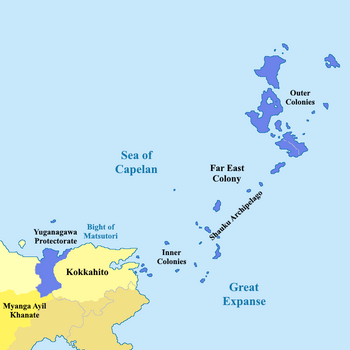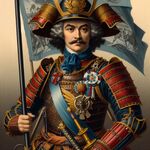Yuganagawa Protectorate
| This article is a stub. You can help IxWiki by expanding it. |
Yuganagawa Protectorate Protectorat Marialanii de Yuganagawa | |
|---|---|
| 1635-1747 | |
|
Flag | |
 Yuganagawa Protectorate in the 1720s | |
| Status | Marialanii Protectorate province of Kokkahito |
| Official language | Burgoignesc |
Common languages | Mutsutori |
| Religion | Shinto |
| Government | Constitutional monarchy |
| Hatamoto-Epistates | |
| Historical era | Age of Discovery, Age of Sail |
• Established | 1635 |
• Disestablished | 1747 |
| Today part of | |
The Yuganagawa Protectorate was formed as the Ai Dynasty recognized the growing threat of the Myanga Ayil Khanate from the west. Impressed by the martial prowess of the Ularien Trading Company (UTC) during the Sea Lords-Daimyo Wars, the Empress made a bold proposal. She offered the Company the opportunity to establish a marcher territory in the western portion of Kokkahito. This territory, named Yuganagawa, would serve as a crucial defense against Myanga Ayil Khanate incursions and protect the Ai's vital trade routes. The UTC readily accepted this proposition. Establishing Yuganagawa provided strategic benefits for both entities. The Ai gained a bulwark against the Khanate, while the UTC secured a entrepot from which to expand their influence further east. Additionally, Yuganagawa offered an opportunity for economic development, with the potential to exploit natural resources for the benefit of the Company.
The establishment of Yuganagawa marked a shift in focus for the UTC. For the next decade, the Company's energies shifted towards expanding the territory southward. This strategy aimed to put pressure on the northern flank of the Myanga Ayil Khanate and relieve pressure on the Duchy of Marialanus' Cote d'Or colony in modern day Kandara.
The governance of Yuganagawa walked a tightrope. The Company administration sought to maximize profits through trade and resource extraction, while the Ai Dynasty desired a bulwark against the Khanate threat. Maintaining this balance was a constant challenge. Tensions occasionally flared between the Dericanian administrators and the Mutsotori populace, particularly regarding taxation and labor practices. However, the shared threat from the Khanate and the need for economic prosperity usually served to quell these conflicts.
Governance and administration
Yuganagawa was treated by the emperesses of Kokkohito as a Ken Prefecture ruled over by a Hatamoto-Epistates appointed by the Duke of Marialanus and ordained by the Emperor.
Beneath the Hatamoto-Epistates existed a complex bureaucratic structure. The UTC, known for its efficiency, implemented a tiered system. Upper echelons were staffed primarily by Dericanian officials, responsible for trade, taxation, and military matters. Lower administrative positions were gradually filled by Mutsotori people who demonstrated competence and loyalty. This localization helped bridge the cultural gap and eased tensions between the rulers and the ruled. As the territory expanded beyond the the initial realm of the Kokko new fiefs were assigned to Patroons both of Mutsotori and Dericanian descent.
| Portrait | Reign | Accomplishments of note | |
|---|---|---|---|
| Alixandre-Julian Bourcier leMahieu | 
|
1635-1657 | Killed in battle against the Myanga Ayil Khanate |
| Fouet-Rogier Cuvillier duVallee | 
|
1657-1683 |
|
| Henricus-Joseph Chopine Vidale | 
|
1683-1701 | |
| Ouidinet-Pierrey Pasquier Arsenault | 
|
1701-1728 | |
| Martin-Astergale Garnier Bourcier | 
|
1728-1747 |
Military
The Hatamoto-Epistateses commanded the Kokkohito empresses' Army of the West, a force that fluctuated between 5-50,000 men throughout its tenure. The force was a combination of samurai, professional Dericanian soldiers, Mutsotori peasant levies, and enslaved soldiers from the lands they conquered. The officer corps was mixed Dericanian and Mutsotori who grew to respect each other over the century of the army's existence. The greatest strength of the army, when it hit its stride from 1643-1675, was to leverage the strengths of the Dolong and Levantine ways of war and have them build off of each other. After the defeat of the Myanga Ayil Khanate at the Battle of Telmen-Uul, in 1668, the force was reduced in size and importance, and eventually becoming little more than a static border guard.
Economy
copper, lacquer, lacquerware, tea, rice, coffee, pepper, coal, zinc, tin, and slaves.
Tea, black pepper, and slavery were the backbone of the Yuganagawa economy.
See also
